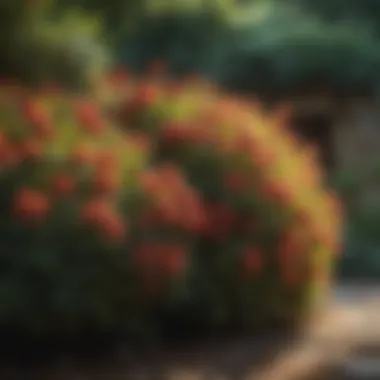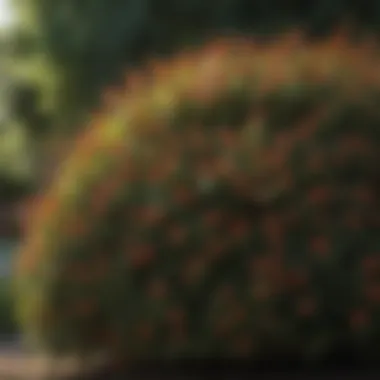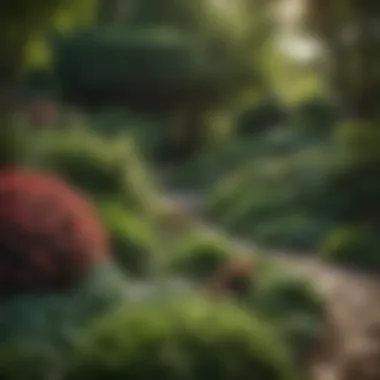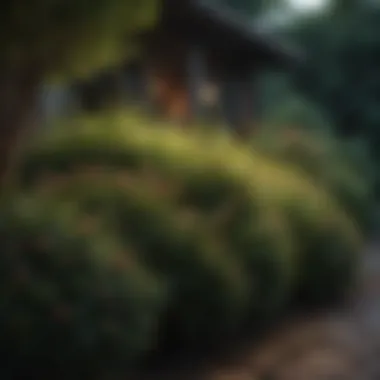Essential Shrubs for Shade: A Guide to Growth


Intro
Creating a vibrant garden in areas that receive less sunlight can feel like trying to find a diamond in the rough. Many homeowners might think that shade spells doom for their gardening ambitions. However, the truth is a little different. Low light areas can be transformed into lush havens with the right shrubs. In this guide, we'll explore how various shrubs can not only survive but thrive under tree canopies or in dim corners of your yard.
Understanding the nuances of these plants, from their care requirements to how to incorporate them effectively into your landscape, will empower you to beautify your space.
Understanding Low Light Conditions
Before diving into the selection of shrubs, it’s vital to grasp what low light conditions really entail. Most plants require a decent amount of sunlight to photosynthesize effectively, but some adapt remarkably well to shadier environments. Recognizing this type of environment, which can include both full shade and partial shade, helps in choosing what will flourish.
- Full Shade: Areas that receive less than three hours of direct sunlight daily.
- Partial Shade: Places with dappled sunlight or up to four to six hours of light.
Shady spots can be a challenge, but they also provide a unique opportunity for creativity in your gardening spaces.
Design Inspiration
When considering shrubs for low-light areas, it's essential to think about the overall design of your garden. Design inspiration isn’t just a matter of picking pretty plants; it embraces how those plants work together to create a cohesive and inviting space.
Current Interior Design Trends
Just like in the world of interiors, gardening has its trends too. This year, the focus is on using greenery not just to complement but to create serene sanctuaries within homes. Incorporating shrubs can play a pivotal role in this trend. Some ideas to consider include:
- Layering: Use taller shrubs at the back and shorter ones at the front to create depth.
- Naturalistic Planting: Emphasizing native species or plants with similar requirements brings an organic feel, binding spaces together.
- Containers and Borders: Shrubs in pots can define spaces, serving both aesthetic and functional roles in shady areas.
Color Palettes and Their Effects
Color psychology can significantly impact how we perceive our outdoor spaces. In shady areas, employing a thoughtful color palette can create harmony and balance.
- Cool Colors: Shades like blues and purples can enhance the tranquility of low-light gardens.
- Warm Tones: Reds, oranges, and yellows might lift and brighten darker areas, but make sure they aren’t overwhelming.
- Green Variations: Different shades and textures of green can provide soothing visual interest throughout the year.
Combining these color principles with suitable shrub choices can really elevate your shade garden into a showcase of natural beauty.
Practical Tips for Selecting Shrubs
When truly delving into selecting the right shrubs for low light, there are a few key factors to weigh:
- Plant Type: Consider both evergreen and deciduous options. Evergreens, like Holly Fern, provide structure all year round, while deciduous varieties, such as Fothergilla, offer stunning seasonal color.
- Texture Variety: Mixing textures can create visual intrigue. Choose a soft-leaved shrub like Japanese Spurge alongside a more rigid option like Boxwood.
- Growth Habit: Some shrubs can spread out significantly. Be mindful of their spacing requirements to avoid creating an overcrowded space.
Making educated decisions about the variety and arrangements of shrubs will help maintain a garden that not only looks appealing but functions well.
To wrap it all up, even the dimmest corners of your yard can hold potential. With creativity and a bit of research on the right shrubs, you can cultivate a space brimming with life and color. The following sections will delve deeper into specific shrub types, care methods, and landscaping strategies that meet the needs of your flourishing shade garden.
Understanding Low Light Conditions
Understanding low light conditions is fundamental when trying to cultivate a thriving shade garden. This section delves deep into the nuances of light availability, how it affects plant choices, and ultimately shapes the overall ambiance of shaded spaces. It’s not just about finding the right shrubs, but also about grasping the concepts that drive their growth and survival in less-than-ideal sunlight. Whether you're an experienced gardener or a newcomer, recognizing these elements can immensely enhance your gardening experience.
Defining Low Light
When discussing gardens, we often perceive them bathed in sunlight. But low light? It’s more than just a lack of bright sunshine. Low light generally refers to areas that receive less than three hours of direct sunlight each day. Think about spaces tucked away under trees or shaded by buildings—these are the neighborhoods where low light plants call home. This kind of environment pushes gardeners to think differently about their plant selections. Low light doesn't imply a garden devoid of life, rather it offers unique opportunities for creativity and biology to thrive in a different rhythm.
Factors Influencing Light Availability
Several factors influence light availability, and understanding them is key to nurturing shrubs that thrive in shady spots. Here are some noteworthy considerations:


- Obstacle Height: Tall trees or buildings may block sunlight, creating darker patches.
- Canopy Density: A dense tree canopy can dramatically reduce light penetration.
- Time of Day: Some areas that seem shady in the morning may bask in sunlight in the afternoon—an important factor for plant selection.
- Geographical Location: Your region's latitude and topography also impact how sunlight filters through.
These factors create a complex interplay that can change how plants react. Thus, taking a moment to observe your garden at various times of day can inform your choices immensely.
Identifying Different Shade Types
Shade isn’t one-size-fits-all; instead, it comes in flavors, each requiring different approaches to planting. You might consider differentiating these common shade types:
- Dappled Shade: Sunlight filters through tree branches, providing a mix of light and shade. Ideal for many shrubs, as they get some intermittent sunlight.
- Partial Shade: Usually means four to six hours of direct sunlight, thus allowing for more versatile planting. Shrubs that tolerate such conditions can often thrive.
- Full Shade: Receives little to no direct sunlight, often demanding more shade-tolerant varieties. Plants must adapt to less light, impacting their growth and flowering.
Identifying the type of shade in your garden enables you to choose the right shrubs more effectively, ensuring a healthy and visually appealing space.
Selecting Shrubs for Low Light Areas
When it comes to building a tranquil and lush landscape, choosing the right shrubs for low light areas is vital. Not only can these plants thrive in limited sunlight, but they also bring a splash of color and texture to your shade garden. It's important to consider the specific attributes and needs of different shrubs since they can significantly affect the overall ambiance of your outdoor space. Selecting the right varieties can lead to easier maintenance and a lush garden that doesn't require constant oversight.
Characteristics of Shade-Tolerant Shrubs
Shade-tolerant shrubs possess several unique characteristics that allow them to flourish in dark corners of your yard. Generally, these plants have larger leaves, which help capture more light, albeit in lower quantities. They often exhibit slower growth rates—an adaptation to conserve energy in dim environments. In addition, many of these shrubs are typically more resilient to pests and diseases, which can be a boon for low-maintenance gardening.
Moreover, look for shrubs with diverse foliage colors and textures. This variety can create visual interest in an area where flowers might be scarce. Shade-tolerant shrubs are also often more adaptable to different soil types, which allows for greater flexibility when planning your garden.
Popular Shrub Varieties for Shaded Spaces
Azaleas
Azaleas are a perennial favorite for shaded areas, and it’s easy to see why. Their vibrant blooms bring life to dull corners, typically appearing in colors like pink, purple, or white. One of the remarkable characteristics of Azaleas is their ability to thrive with minimal sunlight. This makes them a popular choice for gardens where other plants may falter.
However, they do have preference for acidic soil. If your garden's pH level isn't right, you may need to amend the soil accordingly. Despite this drawback, the beauty of Azaleas in bloom can make them well worth the extra effort.
Fothergilla
Fothergilla is another gem that shines in shade gardens. Known for its fragrant white flowers in spring, this shrub also offers stunning fall colors, with leaves turning vibrant shades of orange and yellow. Its key property is its adaptability; it can grow in various situations, from partial to full shade.
A unique feature of Fothergilla is its tolerance for moist soil, which can benefit the overall soil environment in your garden. Although it’s relatively low-maintenance, it does require good drainage to avoid root rot. This shrub is a wise addition for gardeners seeking a long-term, dynamic landscape.
Camellias
Camellias are the epitome of elegance among shade-loving plants. These evergreen shrubs are celebrated for their glossy foliage and luxurious blooms, often appearing in late winter or early spring. One notable characteristic is their ability to maintain green leaves year-round, providing continuity amid seasonal shifts.
If you're looking for color in the colder months, Camellias serve as vibrant accents against the muted winter landscape. However, they do prefer slightly acidic soil and may need a bit of mulch to retain moisture. They can be tricky to grow in heavy clay, but with attention to soil structure, these shrubs can thrive beautifully.
Japanese Holly
Japanese Holly offers a more classic look with its dense, evergreen foliage, often appearing like a refined hedge. It’s known for its toughness; this shrub does well in various lighting conditions, making it somewhat versatile compared to other shade-loving options.
What sets it apart is its shiny leaves and small, black berries that form in the fall. It requires little upkeep, which adds to its appeal. But a word of caution—its growth can be rather slow, meaning it may take a while to establish itself. Nevertheless, for those patient enough, the Japanese Holly can frame your garden with elegance.Well worth it.
Native Shrubs for Sustainable Gardening
Focusing on native shrubs is a sustainable practice that can enrich your shade garden while supporting local wildlife. Native plants are better adapted to the local environment, requiring less water, fertilizer, and pest control. Examples include the Eastern Redbud or the Serviceberry, both of which can serve as beautiful, productive additions to shady spots. By using native varieties, not only are you enhancing biodiversity, but you also create a natural habitat that encourages local pollinators and beneficial insects.
Caring for Low Light Shrubs


Caring for shrubs that thrive in low light conditions is more than just planting them and watching them grow. It’s a delicate dance of meeting their needs while working within the limits of their environment. These plants require a unique approach, as they navigate through less sunlight which poses specific challenges. Understanding the care for these shrubs ensures they not only survive but also flourish, enhancing the beauty of shaded areas. By nurturing them correctly, homeowners can enjoy a vibrant garden that thrives despite the lack of direct sunlight.
Soil Requirements
The foundation of any thriving garden begins with the soil. Low light shrubs often prefer well-draining soil that retains moisture without becoming waterlogged. This balance is critical because overly saturated soil can kill the roots, while overly dry soil can lead to stress.
When planting, consider mixing organic matter such as compost or well-rotted manure into the soil. This not only improves drainage but also increases the nutrient content, allowing shrubs to develop strong roots.
- Look for soils rich in organic material.
- Use mulch to help retain moisture.
- Test pH levels, aiming for slightly acidic to neutral (6.0 to 7.0).
Pro Tip: Regularly check the soil's moisture levels with your finger. If it feels dry an inch down, it’s time to water.
Watering Techniques
In areas where sunlight is scarce, moisture can be both a friend and a foe. Low light shrubs need consistent watering, but the frequency often depends on the specific plant type. A general rule of thumb is to water deeply but infrequently. This encourages roots to grow deeper, promoting resilience.
- Water early in the morning to minimize evaporation.
- Use soaker hoses or drip irrigation systems to target the roots directly.
- Pay attention to any signs of wilting or yellowing leaves, as these can indicate either over or under-watering.
Keeping an eye on the weather can also help tailor your watering routine. If it��’s been rainy, cut back on watering.
Fertilization Best Practices
While many low light shrubs can survive without heavy feeding, providing them with the right nutrients at the right time can significantly enhance their growth and blooming potential. The best approach to fertilization is to use a slow-release fertilizer that provides a steady supply of nutrients through the growing season. Generally, feed shrubs in early spring as new growth begins.
- Consider organic options like fish emulsion or bone meal for a more traditional approach.
- Refrain from fertilizing during fall, as it may interfere with the plant's natural dormancy.
- Use a balanced fertilizer with equal parts nitrogen, phosphorus, and potassium to support overall health.
Pruning and Maintenance
Pruning is one of those tasks that can be both a chore and a blessing. It plays a pivotal role in maintaining the health and aesthetics of low light shrubs. Regular pruning helps in removing dead or diseased branches and encourages air circulation, which is essential in shaded environments.
- Aim to prune immediately after flowering for those shrubs that bloom on old wood.
- For shrubs that flower on new wood, late winter or early spring pruning is best.
- Be cautious not to over-prune, as this can weaken the plant.
"Maintenance isn’t just about trimming and cleaning; it’s about engaging with your garden to promote balance and health."
Understanding how to care for low light shrubs isn’t merely an afterthought in gardening; it’s a crucial component that ensures a vibrant, healthy landscape. Navigating the nuances of soil, watering, fertilizing, and pruning will result in lush gardens that sing with life, even in the shadows.
Designing with Low Light Shrubs
Gardening in shade presents its own set of challenges and rewards. Understanding the nuances of designing with low light shrubs is essential for creating spaces that are not only beautiful but also functional. These shrubs can bring life to areas that may seem bleak or uninspiring, thus transforming them into lush environments. The right design choices can maximize visual appeal, create depth, and lead you to a more sustainable garden as part of your home.
Creating Visual Interest in Shade Gardens
When dealing with the dimmer corners of your garden, it’s crucial to cultivate interest visually. Plants in low light often have distinct textures, colors, and forms. Imagine a sea of greens, punctuated by the soft pinks of Azaleas or the creamy whites of Fothergilla. Each of these shrubs contributes not just through their flowers, but their foliage as well. Consider using bold, evergreen varieties like Japanese Holly to anchor your design throughout the seasons. Such strategic choices give color and life even in the winter months.
To enhance visual interest, think in layers and patterns. Mixing shrubs with different foliage colors and growth habits results in a vibrant tapestry. You might also consider seasonal changes in color; certain shrubs may bloom in spring while others shine in late summer, thus maintaining a dynamic look. Adding textures, such as rough-leafed shrubs next to smooth-leafed ones, can also captivate the eye.
Layering Shrubs for Depth
Layering is key to creating dimension in a shade garden. Consider placing taller shrubs at the back, such as towering Camellias, progressing down to shorter ones towards the front. This approach can lead to a wonderful cascade effect, where each plant interacts with its neighbors, maximizing visibility without overshadowing them. Layering not only provides a scenic view from different angles but also stirs curiosity in the garden. Visitors will want to wander deeper into the space, discovering what lies ahead.
A well-thought-out layer can also help with light availability. While the shrubs in front may not receive as much sunlight, their growth can still be robust, given that the tall plants like Holly don't block every beam of soft light that filters through. By creating this landscape, you’ll encourage a more interactive journey within your garden, inviting both wildlife and human visitors to explore.
Incorporating Hardscape Elements


Don’t forget the powerful role hardscape elements play in a shade garden. Pathways made from natural stone or decorative gravel serve as both functional and aesthetic additions. They can frame your shrubs and provide clear directions for movement through the garden. Consider placing boulders or logs within the landscape as seating or visual markers to break up the planting.
Moreover, trellises and fences are more than barriers; they can create vertical interest. Vine-friendly shrubs can be a great pair with these structures. For example, combining climbing vines like Clematis with a low-growing shrub such as Fothergilla can give a striking height to your shade garden, increasing its overall appeal tremendously.
Common Challenges in Shade Gardening
Creating a thriving shade garden isn't just about choosing the right shrubs; it comes with its share of challenges that every gardener must navigate. Understanding these obstacles sensitizes gardeners to the unique needs of low-light conditions and helps them devise effective management strategies. Some might say that shade gardens are like hidden gems—beautiful yet often overlooked, and like any jewel, they need proper care and attention to shine.
Gardening in shaded areas offers unique advantages, like cooler temperatures and reduced water evaporation. However, specific elements like pests, soil conditions, and seasonal changes can complicate the task. This section aims to break down these challenges and provide practical insights for homeowners and gardening enthusiasts seeking to turn their shady spots into lush sanctuaries.
Pest and Disease Management
Pests and diseases can wreak havoc in any garden, and shade gardens are no exception. The limited sunlight makes some shrubs more susceptible to mold and mildew. Fungal diseases often thrive in damp, shaded areas where air circulation is poor. For instance, if you notice that your azaleas are wilting, it could be due to Phytophthora, a root rot disease that likes to settle in wet conditions.
To manage these pesky problems:
- Regular Inspections: Check plants frequently for unusual discoloration or wilting. Early detection is key.
- Fungicidal Treatments: Use organic fungicides as a preventive measure or to treat existing outbreaks. Neem oil is a popular choice in the gardening community.
- Cultural Practices: Improve air circulation by spacing your shrubs adequately, and try to prune back overgrown branches that might shade too much.
"An ounce of prevention is worth a pound of cure," as the saying goes, so being proactive can save you a heap of trouble down the line.
Dealing with Soil Compaction
Soil compaction is another challenge that can easily stymie growth in shaded areas. When the earth becomes too compacted, it can restrict root growth and hinder the movement of air and water—two elements that are essential for a flourishing garden. Areas under tree canopies often face this issue as foot traffic, along with heavy rain, can compress the soil.
To combat soil compaction:
- Aeration: Regularly aerate the soil, especially in high-traffic areas, so the roots can spread easily and access nutrients.
- Mulching: Apply a thick layer of organic mulch around shrubs to retain moisture, prevent weeds, and add nutrients as it breaks down.
- Soil Amendments: Consider incorporating coarse sand or perlite into the soil mix to improve drainage and aeration.
Never underestimate the power of good soil; it’s the foundation of any successful garden.
Seasonal Considerations
The changing seasons bring a myriad of challenges to shade gardens, with each cycle offering its own unique set of hurdles. In spring, the excitement of new growth can be dampened by late frosts that may catch unprepared gardeners off guard. Summer heat, although usually less intense in shaded areas, can still cause stress if temperatures spike unexpectedly.
- Frost Protection: Cover delicate shrubs with frost cloths during those chilly spring nights. This extra layer can make a world of difference in protecting tender shoots.
- Shade from Heat: In the peak of summer, ensure your garden is not losing hydration. Check the moisture levels consistently, as there's a fine line between too much and too little water.
- Autumn Cleanup: As leaves begin to fall, remember to clear debris which can harbor pests and diseases over the winter months.
In short, observing and adapting to seasonal changes can make or break your shade garden's long-term success.
Staying vigilant and prepared for seasonal shifts is crucial in nurturing a garden that truly reflects the beauty of its circumstances.
The Future of Shade Gardening
Gardening in low light is evolving. As we become more aware of our environment and the challenges posed by climate change, the interest in shade gardening continues to grow. Low light areas, often neglected, have potential that, when nurtured, can reveal stunning landscapes.
The importance of this topic lies in the realization that shade gardens are no longer just about survival— plants in these areas can thrive, offering color, texture, and beauty. Homeowners and designers are beginning to appreciate the value of creating vibrant spaces under the canopy of trees or alongside structures that block sunlight. The future of shade gardening is not only about choosing the right shrubs but understanding their role in sustainable landscaping and biodiversity.
Emerging Trends in Low Light Landscaping
One noticeable trend is the adoption of shade gardens in urban settings. With cities expanding, space is often at a premium, and gardens are evolving into more efficient use of land. Low light landscaping promotes the use of vertical gardens and innovative planting methods to maximize space. Using containers or vertical installations can overcome the limitations imposed by shaded areas, allowing plant lovers to bring greenery into even the most constricted environments.
In the realm of plant choices, hybrids are making waves. Plant breeders are working hard to create new varieties of shrubs that are not just shade-tolerant but also resilient against pests and diseases. These new selections offer better colors, flowering times, and resistance to less-than-ideal conditions. The trend of integrating native species into shade gardens continues to gain traction. Incorporating shrubs that are indigenous to the area helps to create a healthier ecosystem while requiring less maintenance.
“Gardening is a means of waking the soul to the fullness of life.”
Innovative Practices for Sustainability
Sustainability is a key focus for the future of gardening. Throughout shade gardens, there's a push for using organic gardening practices. Homeowners are looking to reduce their impact on the environment while cultivating beautiful spaces. Using compost and organic mulch not only nourishes the shrubs but helps retain moisture and enrich the soil.
The integration of rain gardens is also on the rise. These gardens capture rainwater runoff, providing an additional watering source for shade plants. Additionally, practices like minimizing lawn areas and replacing them with shrubs can reduce maintenance and resource use significantly.
Planting in layers is another innovative practice gaining popularity. This method allows different species to coexist while maximizing light utilization. Tall shrubs can provide shelter for smaller plants underneath, promoting biodiversity and enhancing the visual appeal.















